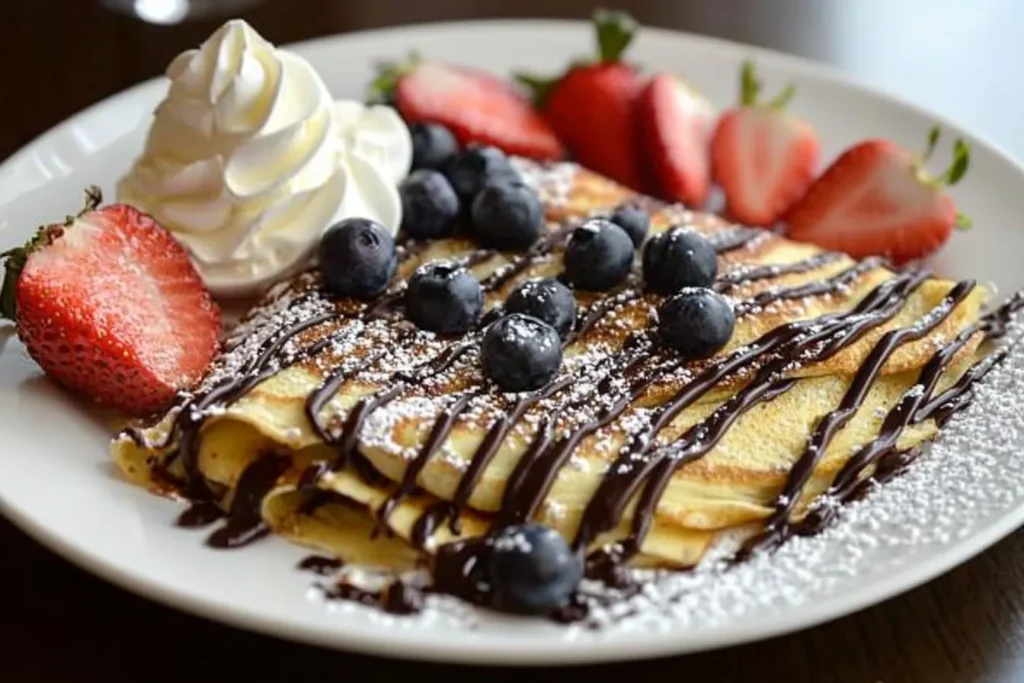Have you ever tried making crepes at home, only to have them turn out too thick, torn, or just… not quite right? Don’t worry—you’re not alone! Crepes can seem tricky, but the truth is, the secret to a good crepe isn’t complicated. In fact, it’s all about a few simple tips that anyone can master. Whether you’re making them for a special breakfast, a dessert treat, or even a savory dinner, learning the key to perfect crepes can save you a ton of frustration and make you feel like a kitchen pro. I’ve been there too, staring at my first crepe disaster, wondering what went wrong. But once you know the little tricks—resting the batter, using the right pan, and mastering the flip—it’s a total game-changer. Ready to turn crepe-making into your new favorite skill? Let’s dive in!
List Of Contents
Introduction to Crepes
Crepes are a culinary treasure, a versatile dish that can be tailored for every palate. Thin and delicate, crepes are not just another pancake—they’re a French classic that has taken the world by storm. Originating in Brittany, France, crepes have evolved into a global delight, offering endless possibilities for fillings and flavors.
Crepes can be categorized into two primary types: sweet crepes (crêpes sucrées) and savory crepes (crêpes salées). Sweet crepes are often served with fruits, chocolate, or sugar, while savory crepes, commonly made with buckwheat flour, are filled with meats, cheeses, or vegetables. This duality makes crepes a favorite for breakfast, lunch, dinner, or dessert. Check out more recipes here.
Key Ingredients for Crepes
A perfect crepe begins with its ingredients. Each element plays a critical role in achieving the right texture and flavor.
Importance of Flour Selection
The type of flour determines the texture of your crepes. All-purpose flour is the standard choice, but using buckwheat flour adds a nutty flavor ideal for savory options. Always sift the flour to avoid lumps in your batter.
The Role of Eggs in Crepe Batter
Eggs act as a binding agent, lending structure and richness. For a silky batter, use fresh, room-temperature eggs.
Milk and Liquid Ratios for Perfect Consistency
The liquid ratio is vital. A mix of milk and water provides the perfect balance of richness and lightness. Opt for whole milk for creamy crepes, or substitute with almond or oat milk for a dairy-free option.
The Science of Crepe Batter
Creating a flawless batter requires patience and precision. Here’s what you need to know:
- Why Resting the Batter Matters: Resting the batter for at least 30 minutes allows the flour to hydrate, resulting in more pliable crepes.
- Avoiding Lumps: Mixing Techniques: Gradually incorporate wet ingredients into the dry, whisking steadily. For a foolproof solution, use a blender.
- The Ideal Batter Consistency: The batter should have the texture of heavy cream—neither too thick nor too watery.
Selecting the Right Tools
Having the proper tools can elevate your crepe-making experience:
- Best Pans for Crepe Making: Use a non-stick or cast-iron crepe pan with low sides for easy flipping.
- Ladles, Spreaders, and Spatulas: A ladle ensures even batter distribution, while a wooden spreader and thin spatula help achieve the perfect thinness.
- Importance of Non-Stick Surfaces: Non-stick surfaces minimize tearing and ensure smooth cooking.
Preparing the Perfect Cooking Environment

Cooking crepes demands attention to heat and technique:
- Achieving the Right Pan Temperature: Medium heat works best. Test the temperature by sprinkling a few drops of water on the pan—if they sizzle and evaporate quickly, it’s ready.
- Even Heat Distribution: A consistent heat source ensures uniform cooking.
- Timing and Technique for Swirling Batter: Pour batter into the center and quickly swirl to coat the pan evenly.
Common Mistakes in Crepe Making
Avoid these pitfalls to master your crepes:
- Overmixing the batter can make it tough.
- Skipping the resting time results in less elastic crepes.
- Cooking at the wrong temperature leads to burnt or undercooked crepes.
Perfect Crepe Texture
Achieving the ideal texture involves a balance of technique and patience:
- For light and airy crepes, ensure your batter is smooth and evenly spread.
- A crisp edge can be achieved by lightly greasing the pan.
- Avoid rubbery crepes by not overcooking and keeping the batter thin.
Ingredient Substitutions for Dietary Needs
Crepes can be adapted for all dietary preferences:
- Gluten-Free Crepe Alternatives: Use rice flour or a gluten-free blend.
- Dairy-Free and Vegan Options: Replace milk with plant-based options and eggs with aquafaba or flaxseed.
- Using Alternative Sweeteners: Honey, maple syrup, or stevia can substitute sugar.
Cultural Variations in Crepes
Crepes have inspired culinary innovations worldwide:
- French Crepes vs. Russian Blinis: French crepes are thin and large, while blinis are thicker and smaller.
- Asian-Inspired Crepe Styles: Popular street-food crepes in Japan feature unique fillings like matcha and red bean.
- Modern Twists on Traditional Recipes: Chefs now experiment with fusion crepes, blending cultural cuisines.
The Importance of Practice and Patience
Mastering crepes takes time:
- The first crepe is often imperfect—use it as a trial run for pan temperature and batter consistency.
- Explore and refine your methods to discover what yields the best results.
- Practice will eventually lead to flawless, Instagram-worthy crepes.
Techniques and Expert Tips for Crepe Perfection
The Perfect Batter-Making Process
Crafting a flawless batter is the cornerstone of exceptional crepes. Follow these steps to elevate your batter-making game:
- Measuring Ingredients Accurately: Precision matters. Utilize measuring cups or a kitchen scale to achieve consistent outcomes with every attempt.
- Combining Wet and Dry Ingredients Correctly: Gradually add the wet ingredients into the dry to avoid lumps. Maintain a steady whisking rhythm to ensure a smooth texture.
- Using a Blender vs. Manual Whisking: For a seamless texture, a blender can work wonders, ensuring no lumps. However, whisking manually provides more control over the batter’s thickness.
Pro tip: Always strain the batter to remove any stubborn lumps before cooking.
Achieving the Right Cooking Balance
Perfect crepes require precise timing and heat management. Here’s how:
- How to Properly Preheat Your Pan: Allow your pan to heat for 2–3 minutes over medium heat. Test the surface by sprinkling water; if it dances, the pan is ready.
- Timing the Flip for Optimal Results: Flip the crepe when the edges start to lift slightly, and bubbles form on the surface. This usually takes 1–2 minutes.
- To prevent burnt edge: distribute heat evenly and use a moderate amount of oil in the pan.
Flavor Enhancement in Crepes
Elevate the taste of your crepes by incorporating imaginative toppings and fillings:
- Adding Vanilla or Citrus Zest for Sweet Crepes: A dash of vanilla extract or the zest of a lemon can elevate the taste dramatically.
- Infusing Savory Crepes with Herbs and Spices: Consider adding chopped chives, parsley, or smoked paprika to your batter for a savory twist.
- The Importance of Fats: Incorporating melted butter into the batter adds a rich flavor, while a neutral oil like sunflower promotes uniform cooking
Filling and Presentation Techniques

Crepes are a canvas for culinary creativity. Here’s how to fill and present them beautifully:
- Classic Fillings for Sweet Crepes: Nutella, strawberries, whipped cream, and powdered sugar are timeless favorites.
- Savory Crepes: Cheese, Vegetables, and Meats: Experiment with brie, sautéed mushrooms, spinach, and smoked salmon for a gourmet experience.
- Folding and Rolling Styles: Aesthetic Appeal: Master classic styles like triangles, rolls, or the fan-shaped fold for a stunning presentation.
Pairing Crepes with Sides and Beverages
Pairing crepes with complementary sides and drinks creates a complete dining experience:
- Fruits, Creams, and Sauces for Sweet Crepes: Fresh berries, chocolate drizzle, and crème anglaise are perfect accompaniments.
- Salad and Soup Pairings for Savory Crepes: A crisp side salad with vinaigrette or a creamy soup balances the richness of savory fillings.
- Choosing the Right Coffee, Tea, or Wine: A cappuccino pairs well with sweet crepes, while dry white wine enhances savory flavors.
Troubleshooting Crepe Problems
Even seasoned cooks encounter challenges. Here’s how to address common issues:
- Fixing Thick and Heavy Crepes: Thin the batter with a splash of milk or water to achieve the desired consistency.
- Dealing with Batter That Tears Easily: Ensure the pan is well-greased and the batter evenly distributed. Resting the batter also improves elasticity.
- Salvaging Burnt or Undercooked Crepes: Adjust the pan temperature, and don’t hesitate to start fresh with a well-preheated pan.
Advanced Techniques for Crepe Artists
Take your crepe-making skills to the next level with these advanced methods:
- Layering Crepes for Mille-Crepe Cakes: Stack crepes with layers of pastry cream or ganache for a show-stopping dessert.
- Creating Decorative Patterns with Batter: Use a squeeze bottle to create intricate designs before spreading the batter.
- Mastering Flambé Techniques: Add a splash of liqueur, such as Grand Marnier, and ignite for a dramatic presentation.
Seasonal and Festive Crepes
Celebrate the seasons with themed crepes:
- Winter Holiday Crepes: Warm and Spiced: Add cinnamon, nutmeg, and cloves for a cozy touch. Pair with mulled wine for a festive feel.
- Spring and Summer Fruit Crepes: Fill with fresh strawberries, mangoes, or a dollop of mascarpone.
- Autumn-Inspired Savory Crepes: Incorporate pumpkin puree, sage, and goat cheese for a fall-inspired dish.
Crepes for Special Occasions
Impress your guests with crepes tailored to the occasion:
- Romantic Crepes for Two: Heart-shaped crepes with chocolate and berries are perfect for date nights.
- Elegant Crepes for Brunch Events: Serve savory crepes with smoked salmon and dill sauce for an upscale brunch.
- Birthday and Celebration Crepe Ideas: A layered crepe cake with candles makes for a unique birthday treat.
Storing and Reheating Crepes
Proper storage ensures your crepes stay fresh and delicious:
- How to Store Crepes Without Losing Quality: Place parchment paper between crepes and store in an airtight container in the fridge for up to three days.
- Reheating Techniques for Freshness: Warm crepes in a non-stick pan over low heat or in the microwave for 10–15 seconds.
- Using Leftover Crepes Creatively: Turn leftover crepes into lasagna layers or cut them into strips for a unique pasta alternative.
Exploring the World of Crepes and Beyond

International Crepe Recipes
Crepes have traveled the globe, adapting to regional flavors and techniques. Here are some standout international variations:
- French Breton Galettes: Made with buckwheat flour, these savory crepes are gluten-free and often filled with ham, cheese, and egg. The slightly nutty flavor of buckwheat complements savory fillings beautifully.
- Japanese Street-Style Crepes: A popular street food, Japanese crepes are thin, crispy, and filled with everything from whipped cream and fruit to savory options like teriyaki chicken.
- Mexican Crepas de Cajeta: These dessert crepes are filled with cajeta (caramelized goat’s milk) and topped with nuts, creating a rich and indulgent treat.
Crepes and Health Trends
Modern dietary preferences have inspired healthier crepe recipes, allowing everyone to enjoy this classic dish:
- High-Protein Crepe Variations: Substitute traditional flour with protein-rich alternatives like almond or chickpea flour. Add Greek yogurt or protein powder to the batter for an extra nutritional boost.
- Keto-Friendly Crepe Ideas: Use almond flour, coconut flour, or psyllium husk to create low-carb crepes, and fill with cream cheese or smoked salmon for a keto delight.
- Organic and Whole Food Crepes: Opt for organic eggs, milk, and whole-grain flours for a healthier twist on traditional recipes.
The Role of Crepes in Culinary Culture
Crepes hold a special place in the culinary world, from street food to fine dining:
- Crepes as a Street Food Staple: In Paris, crepes are an everyday indulgence, served from kiosks and food trucks to satisfy hungry locals and tourists alike.
- High-End Restaurants Serving Crepes: Fine-dining establishments have reimagined crepes as gourmet dishes, filled with luxury ingredients like truffle, foie gras, or lobster.
- Crepes in Pop Culture and Media: From French films to global cooking shows, crepes often symbolize elegance and culinary craftsmanship.
Experimenting with Fusion Crepes
Crepes are a canvas for culinary creativity, blending cuisines from around the world:
- Combining Crepes with Asian Cuisine: Fill crepes with stir-fried vegetables, hoisin sauce, and roasted duck for an Asian-inspired twist.
- Crepes Meets Tacos: Creative Fusions: Use crepes as a substitute for taco shells, filling them with spiced meats, guacamole, and salsa for a unique Tex-Mex experience.
- Dessert Crepes with Exotic Flavors: Infuse batter with matcha powder or rose water, and top with tropical fruits like dragon fruit or lychee.
Popular Crepe Toppings Around the World
Toppings can transform crepes into unique masterpieces:
- French Chocolate and Cream Combos: A drizzle of melted chocolate paired with chantilly cream is a French classic.
- Italian Gelato and Nut-Based Toppings: Add scoops of gelato and crushed pistachios or hazelnuts for an Italian-inspired dessert.
- Asian-Inspired Sweet and Savory Choices: Incorporate sweet red bean paste, sesame seeds, or even seaweed for a bold, unexpected flavor profile.
Making Crepes Accessible for All Skill Levels
Crepe-making doesn’t need to be intimidating. Here’s how to simplify the process:
- Beginner-Friendly Recipes: Start with basic batter recipes that use pantry staples like all-purpose flour, milk, and eggs.
- Tools and Hacks for Easy Crepe Making: Invest in a crepe spreader and batter dispenser to simplify the cooking process.
- Workshops and Online Tutorials: Take a virtual crepe-making class or follow step-by-step video tutorials to build confidence in your skills.
Sustainable and Ethical Crepe Ingredients
Sustainability can be part of your crepe-making journey:
- Locally-Sourced and Organic Ingredients: Supporting local farmers ensures fresher ingredients and reduces your carbon footprint.
- Reducing Food Waste When Making Crepes: Use leftover batter to make savory crepe wraps or freeze it for future use.
- Ethical Dairy and Egg Choices: Opt for cage-free eggs and organic milk to make your crepes environmentally friendly.
Crepe Innovations in Modern Cuisine
The crepe is evolving with new technology and trends:
- 3D Printed Crepes and Technology: Innovative chefs are using 3D printers to create intricate designs and shapes in crepe batter.
- Gourmet Crepe Menus in Restaurants: High-end restaurants now feature elaborate crepe dishes with artistic plating and fusion flavors.
- Trends in Crepe Presentation: Instagram-worthy crepes are decorated with edible flowers, gold leaf, and intricate lattice designs.
Crepe Challenges and Competitions
Crepes have inspired both casual challenges and professional competitions:
- World’s Largest Crepe Attempts: Enthusiasts worldwide attempt to create record-breaking crepes, sometimes spanning meters in diameter.
- Competitive Crepe Making Events: From flipping contests to artistic crepe decorating, these events showcase the versatility of crepes.
- Setting Personal Crepe Goals: Challenge yourself to master a new filling or perfect your flipping technique.
Conclusion and Call to Action
The possibilities with crepes are endless. Whether you’re mastering classic French recipes or experimenting with global flavors, there’s always something new to discover. Embrace the art of crepe-making, and share your creations with friends and family to spread the joy of this timeless dish.
FAQs
1. How can I make my crepes thinner? Gradually add more liquid to the batter and swirl it quickly in the pan.
2. Can crepe batter be made ahead of time? Yes, it can be refrigerated for up to 24 hours.
3. What is the best flour for gluten-free crepes? Buckwheat or rice flour are excellent gluten-free options.
4. How do I prevent my crepes from sticking? Ensure the pan is non-stick and properly greased.
5. Can I freeze crepes? Yes, stack crepes with parchment paper and store them in an airtight container for up to a month.
6. What’s the difference between a pancake and a crepe? Crepes are thinner and don’t use a leavening agent like baking powder.
7. Can I make vegan crepes? Yes, substitute eggs with flaxseed and milk with almond or oat milk.
8. What’s the ideal pan size for crepes? A 9–12 inch pan works best for most crepes.
9. Why is my crepe batter lumpy? Improper mixing or not sifting the flour can cause lumps.
10. What are some fun crepe toppings for kids? Try Nutella, banana slices, and rainbow sprinkles for a kid-friendly treat.
